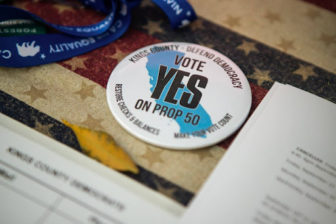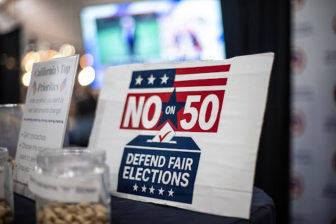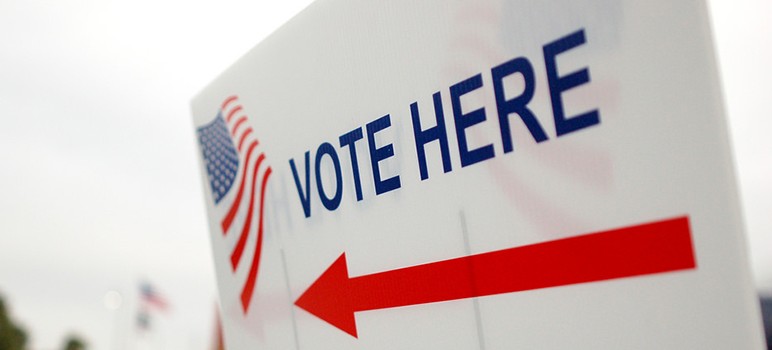As voters face a Nov. 4 deadline to turn in their ballots, California’s redistricting fight has reached a pinnacle as both sides pour tens of millions of dollars on their final push to persuade and mobilize voters.
Opponents of Prop. 50, which would redraw boundaries of many of the state's congressional districts, want voters to resist gerrymandering. Supporters are doing everything they can to make the election about Trump.
The Yes side has largely outraised and outspent its opponents, pulling in nearly $97 million — more than double the No side’s haul of $42 million — and garnered far more big names to appear in its ads.
 Still, recent polling shows the race remains close, and persuasion in the final weeks is critical for both sides.
Still, recent polling shows the race remains close, and persuasion in the final weeks is critical for both sides.
While opponents of Prop. 50 are going all-in on a good governance message and playing on most voters’ unease with politicians drawing their own districts, supporters of the measure are doubling down on anti-Trump rhetoric. And both campaigns are trying to turn out Latino voters, a key constituency that could swing the election.

Bay Area districts would largely be untouched by the redistricting proposal, which targets current districts that have voted for Republican candidates.
Former President Barack Obama wants you to know that the whole nation is counting on you this November.
“Democracy is on the ballot,” the 44th president says straight to camera in the latest advertisement from Gov. Gavin Newsom’s campaign for Proposition 50, the ballot question that asks voters to temporarily gerrymander California’s congressional districts to favor Democrats.
“Republicans want to steal enough seats in Congress to rig the next election and wield unchecked power for two more years,” Obama continues in the seven-figure ad buy airing across California, referring to GOP-led redistricting efforts President Donald Trump has backed in other states like Texas. “With Prop. 50, you can stop Republicans in their tracks.”
A survey from the nonpartisan Cook Political Report earlier this month found that although 50% of registered voters said they would support Prop. 50 and 35% said they would oppose it, nearly half of those surveyed indicated they were undecided or only softly committed to their vote. The poll included 918 registered voters with a sampling error margin of plus or minus 3.6 percentage points.
There’s still plenty of time to sway voters, especially those who are just now tuning into the fact that an election is happening. If voters approve Prop. 50, California would temporarily adopt gerrymandered maps drawn by Democrats through 2030 and suspend the ones drawn by an independent citizens redistricting commission just four years ago. The ballot question informs voters that California’s redistricting is a direct response to Texas Republicans’ decision to redraw their district lines mid-decade.
And when it comes to persuasion, money is critical.
More than 68,000 people have given money in support of the Yes on Prop. 50 campaign since July, according to campaign finance data analyzed by CalMatters, with the biggest contributions coming from the House Majority PAC controlled by congressional Democrats and the Fund for Policy Reform controlled by Democratic megadonor George Soros. That doesn’t include the nearly $13 million that billionaire investor Tom Steyer spent separately to run his own ads supporting the measure.
By contrast, only 200 contributors have given to the two separate No campaigns, including a massive $30 million from wealthy Republican physicist Charles Munger Jr., who funded the 2008 and 2010 efforts to establish the state’s independent redistricting commission.
“‘No’ has the steeper hill to climb, there’s no doubt about that,” said Amy Walter, publisher and editor-in-chief of the Cook Political Report. She explained that opponents of Prop. 50 would not only need to solidify their tentative supporters and ensure they vote, but also persuade all undecided voters and also convert some of the tentative “yes” voters.
But working in the opposition’s favor is widespread unease with the idea of elected officials influencing the shape of their districts. About 56% of the Cook poll’s respondents who indicated they would probably vote “Yes” said they agreed that politicians shouldn’t draw their own district lines.
“If you’re the ‘No’ campaign, it is the one place where you can see you can get some traction,” Walter said.
Opportunity for Prop. 50 opponents
Opponents of Prop. 50 are trying hard to capitalize on that discomfort in their recent advertising.
“Prop. 50 takes us backwards and rips power away from the people,” an unidentified woman tells viewers in a recent No on 50 advertisement. Then the declaration “Politicians Can Rig Elections” flashes across the screen in bold red and black text.
Jessica Millan Patterson, the former state GOP chairperson who is leading the No on 50 campaign backed by House Republicans, said she’s targeting independents and Democrats who are dissatisfied with the party. That means focusing on a limited, simple good-governance message to turn out undecided voters.
Millan Patterson isn’t concerned about mobilizing the Republican base, she said, adding that the Yes campaign is already doing that for her by demonizing Trump and deifying Newsom, whom conservatives despise. In a small nod to the party faithful, the campaign is running one advertisement criticizing the governor. It hammers him on affordability.
“We can’t win with just Republican votes, so we need to make sure that those persuadable voters … that the conversation is happening with them,” Millan Patterson said. “They know that giving this power to politicians, it will not serve anyone but those politicians, and they just need some permission to vote no on this.”
That mirrors the message of the other No campaign paid for by Munger.
“If you look at all the polling since the beginning, voters don’t like gerrymandering, full stop,” said Amy Thoma Tan, spokesperson for that campaign. “So we’re just reminding people that this is gerrymandering.”
California unions settle on Trump message
By contrast, their opponents on the Yes side are investing heavily in an anti-Trump message, a move that Walter said was smart given that the president is “the special catalyst” that helps the Yes side overcome California voters’ traditional preference for rejecting ballot measures.
In digital ads, the powerful California Labor Federation is reminding its 2 million members that Trump has terminated federal workers’ contracts and cut infrastructure spending, which paid for many trades workers’ projects.
But in phone-banking operations, its president Lorena Gonzalez said the catch-all framing of Prop. 50 as a way to “fight back against Trump” works best to motivate voters, who all “know what they’re not happy about.”
“Do we want to talk about ICE? Do we want to talk about LGBTQ (issues)? Do we want to say, ‘fight fascism?’” Gonzalez said of discussion among labor organizers working to turn out students on University of California campuses.
The Service Employees International Union of California is taking an all-of-the-above approach, said Tia Orr, the union’s executive director. A digital advertisement urges viewers to fight back against the Trump administration’s “inhumane immigration policies” by supporting Prop. 50. And a recent mailer sent to SEIU’s 800,000 California members, many of whom work in health care, reminded them that the Republican-controlled Congress approved Trump’s megabill that would take health insurance coverage from an estimated 10 million Americans.
“I urge all registered nurses to volunteer, vote, and share the message with your friends and family,” reads the mailer, written in the first person and signed by Monique Hernandez, vice president of an SEIU local that represents nurses.
In Asian American immigrant communities, pro-Prop. 50 organizers are emphasizing cuts to health care programs and how Trump policies destabilize local economies — a nod to tariffs. For Latino voters, the Yes campaign is airing ads in English and Spanish featuring New York Rep. Alexandria Ocasio Cortez and Democratic Sen. Alex Padilla of California, who was forced to the ground by federal agents in Los Angeles this summer during the height of the immigration raids that jolted the city.
Latino voters the most undecided
Latino voters, the state’s largest racial group and about 30% of likely voters, are a key constituency that could swing the election.
Affordability remains a top priority for Latino voters, a survey by the Latino Community Foundation of 1,200 Latino registered voters in California in September shows. But they also disapproved of the president by wide margins, and felt pessimistic about their personal economic prospects in higher shares than ever, vice president of policy Christian Arana said. By a three-to-one margin they said they felt Trump had betrayed them on immigration.
“There’s a lot of people that say if you really want to talk to Latino voters, you only have to talk about the economy,” said Yes on 50 consultant Juan Rodriguez. “It’s a false choice. You can’t just talk about kitchen-table issues when they’re burning down your house.”
The campaign has spent more than $10 million specifically on Latino outreach, Rodriguez said, including broadcast, digital, print and radio ads in Spanish and English, and phone banking operations with Latino community groups.
Still, Arana called Latinos “the most undecided voter.” Latino approval for Prop. 50 is just under 50% in the Inland Empire and Central Valley, according to the group’s survey, which has a sampling error margin of plus or minus 2.8 percentage points.
Arana is most concerned that fears of immigration or other federal agents showing up to polling places could depress turnout, particularly as immigration raids in California and elsewhere have ensnared U.S. citizens. The survey showed two-thirds of Latino voters statewide are concerned about immigration enforcement this election.
Democratic organizers emphasized in a recent Zoom call for volunteers that they were pushing for early voting by mail instead.
Maya C. Miller and Jeanne Kuang are reporters with CalMatters. Jeremia Kimelman contributed.


Nakedly partisan gerrymandering. To “save democracy”. No on 50.
Not sure why Texas is not mentioned in this article. They did it first, Democrats in California are responding. Very simple, a no vote cancels out the cheating in Texas.
“Democracy is on the ballot” What a load of BS. Leave well enough alone – who benefits from redistricting in CA? The rich and the politician. It is DEFINITELY not for the people or done in their best interests. Our politicians, especially one particular Party, are just whiney Children who are wielding their power to get back at the other side. And millions of Californians will suffer for their insane selfishness. YES on 50 will benefit only a certain few. Let’s call them the Elite for lack of better term (the Obamas et al who got richer while in office somehow).
Robert, Texas was not the first state to redraw congressional districts mid-census. Just last year the Democrats-controlled New York State legislature did so notwithstanding the existence of a nonpartisan commission.
And even if Texas was first, two wrongs don’t make right. Partisan gerrymandering is anti-democratic.